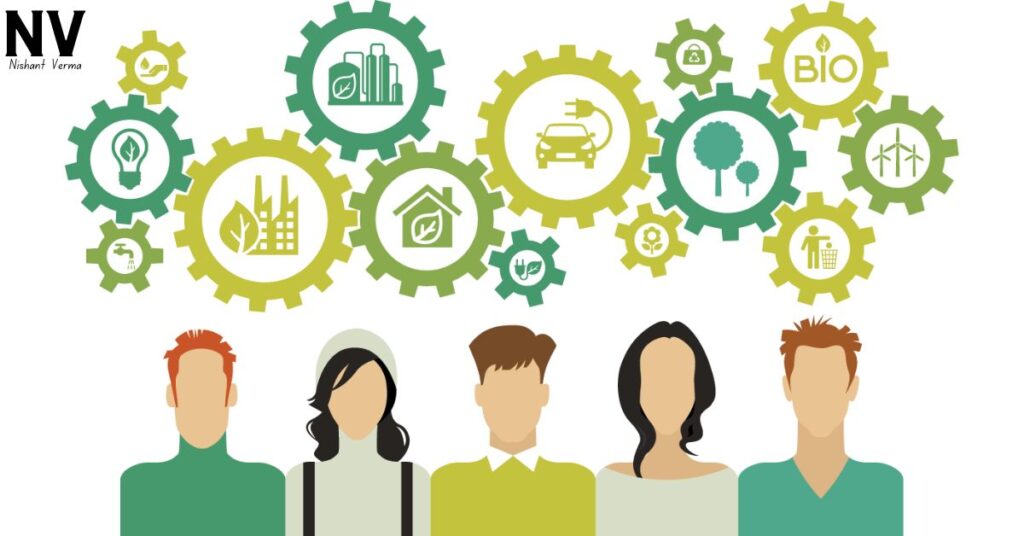In the world of leadership, making a positive impact goes beyond profits—it’s about building a leadership and sustainable future. This article explores the vital connection between leadership and sustainability practices, unraveling what it means, why it matters, and how leaders can steer their organizations towards a greener tomorrow. Join us on this journey as we delve into the essential aspects of sustainable leadership and discover how small changes today can make a significant difference for our planet.

Understanding leadership and sustainable future:
What Are Sustainability Practices?
Sustainability practices are like tending to a garden with care. They involve making choices that benefit the environment, society, and the economy, ensuring that resources are used wisely, and ecosystems are preserved. It’s like a leader who guides their organization to make decisions that contribute to a healthier planet and community.
The Role of Leaders:
Role of Leaders are like captains of a ship steering towards a sustainable destination. They play a crucial role in incorporating eco-friendly practices into their organizations, inspiring positive change and influencing others to follow suit. If leaders focus on sustainability practices effectively, they become the captains who navigate their organizations towards a greener and more responsible future.
Elements of Sustainability Practices for a Greener Tomorrow:
Implementing Energy Efficiency:
Implementing energy efficiency is like turning off unnecessary lights when not needed. Leaders guide their organizations to use energy wisely, adopting technologies and practices that reduce energy consumption. It’s like a captain who ensures the ship’s engines run efficiently to conserve fuel during the voyage.
Reducing Waste and Recycling:
Reducing waste and recycling is like separating recyclables from trash at home. Leaders encourage their organizations to minimize waste, recycle materials, and adopt circular economy principles. It’s like a captain who ensures that waste generated on the ship is managed responsibly, leaving minimal impact on the ocean.
Embracing Sustainable Sourcing:
Embracing leadership and sustainable future sourcing is like choosing products with eco-friendly labels. Leaders guide their organizations to source materials responsibly, considering environmental and social impacts. It’s like a captain who ensures that the ship’s provisions are sourced from vendors committed to ethical and sustainable practices.
Promoting Green Transportation:
Promoting green transportation is like choosing electric or hybrid vehicles over traditional ones. Leaders encourage leadership and sustainable future commuting options and invest in eco-friendly transportation solutions. It’s like a captain who opts for cleaner fuels and efficient navigation practices to reduce the ship’s carbon footprint.
Advocating for Social Responsibility:
Advocating for social responsibility is like supporting local communities during the voyage. Leaders guide their organizations to engage in socially responsible initiatives, contributing to community well-being and supporting social causes. It’s like a captain who ensures that the ship’s presence positively impacts the communities it encounters.

Why leadership and sustainable future Practices Matter:
Preserves the Environment for Future Generations:
Sustainability practices preserve the environment for future generations. When organizations adopt eco-friendly measures, it ensures that natural resources are conserved, reducing the impact on ecosystems. It’s like a captain who navigates the ship without harming marine life, preserving the ocean for generations to come.
Creates a Positive Brand Image:
Sustainability practices create a positive brand image. When organizations prioritize environmental and social responsibility, it enhances their reputation and attracts customers who value ethical practices. It’s like a captain whose responsible navigation practices make the ship a symbol of environmental stewardship.
Fosters Employee Engagement:
Sustainability practices foster employee engagement. When organizations prioritize sustainability, it resonates with employees who want to work for socially responsible and environmentally conscious employers. It’s like a captain who ensures a positive and ethical ship culture, fostering crew members’ pride in their work.
Reduces Operational Costs:
Sustainability practices reduce operational costs. When organizations optimize resource use and implement energy-efficient solutions, it leads to cost savings in the long run. It’s like a captain who efficiently manages the ship’s resources, ensuring a cost-effective and sustainable journey.

Implementing Strategies for Sustainability Practices:
Conducting Energy Audits:
Conducting energy audits is like checking the ship’s engine for efficiency. Leaders assess their organization’s energy usage, identify areas for improvement, and implement energy-saving measures. It’s like a captain who ensures the ship’s engines are well-maintained and operate at peak efficiency.
Establishing Recycling Programs:
Establishing recycling programs is like organizing waste bins for different materials on the ship. Leaders implement recycling initiatives, educate employees, and collaborate with waste management services to reduce waste. It’s like a captain who ensures recycling bins are available throughout the ship, encouraging responsible waste disposal.
Partnering with Sustainable Suppliers:
Partnering with leadership and sustainable future suppliers is like choosing reputable vendors for ship provisions. Leaders collaborate with suppliers committed to eco-friendly practices, ensuring that sourced materials align with sustainability goals. It’s like a captain who selects suppliers with a track record of ethical and sustainable sourcing.
Promoting Remote Work and Sustainable Commuting:
Promoting remote work and leadership and sustainable future commuting is like offering flexible work options for the crew. Leaders encourage telecommuting, implement carpooling initiatives, and invest in eco-friendly transportation alternatives. It’s like a captain who supports crew members in adopting green computing practices during shore leave.
Engaging in Community Outreach:
Engaging in community outreach is like organizing beach clean-ups during port visits. Leaders initiate and participate in community service projects, contributing to local environmental and social causes. It’s like a captain who involves the crew in activities that benefit the communities they visit.
Case Studies: Real-Life Examples of leadership and sustainable future:
Patagonia’s Commitment to Sustainability:
Patagonia, an outdoor clothing company, is a notable example of sustainable leadership. The company emphasizes eco-friendly materials, fair labour practices, and environmental initiatives. Patagonia’s commitment to sustainability not only aligns with its brand values but also attracts environmentally conscious consumers.
Unilever’s Sustainable Living Plan:
Unilever, a consumer goods company, has implemented a leadership and sustainable future Living Plan that focuses on reducing environmental impact and promoting social responsibility. The company aims to source 100% of its agricultural raw materials sustainably and improve the well-being of one billion people by 2030.
Challenges and Solutions in Implementing Sustainability Practices:
Overcoming Resistance to Change:
Leaders address resistance to change by communicating the benefits of sustainability practices, involving employees in decision-making, and providing education on environmental and social impacts. It’s like a captain explaining the advantages of eco-friendly navigation practices to gain the crew’s support.
Balancing Short-Term and Long-Term Goals:
Leaders balance short-term and long-term goals by prioritizing sustainability initiatives that align with the organization’s overarching vision. It’s like a captain planning each voyage with both immediate challenges and long-term destinations in mind.
Conclusion:
In the vast sea of leadership, sustainability practices are the wind that propels the ship towards a greener horizon. Fostering an environment where eco-friendly choices, social responsibility, and ethical practices are valued is not just a task; it’s the essence of creating a workplace where every team member contributes to a journey of environmental stewardship.
By understanding the elements of sustainability practices, recognizing their significance, and implementing strategies effectively, leaders become the captains of a ship that sails confidently towards a future where businesses thrive and the planet flourishes. In essence, sustainability practices are not just a set of guidelines; they’re the compass that guides the ship towards a more responsible and leadership and sustainable future tomorrow in the dynamic world of leadership.




